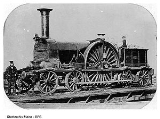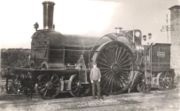
Bristol and Exeter Railway 4-2-4T locomotives
Encyclopedia

Broad gauge
Broad-gauge railways use a track gauge greater than the standard gauge of .- List :For list see: List of broad gauges, by gauge and country- History :...
4-2-4T steam locomotives built to three different designs. The first entered service in 1853. The Bristol and Exeter Railway
Bristol and Exeter Railway
The Bristol & Exeter Railway was a railway company formed to connect Bristol and Exeter.The company's head office was situated outside their Bristol station...
was amalgamated
Consolidation (business)
Consolidation or amalgamation is the act of merging many things into one. In business, it often refers to the mergers and acquisitions of many smaller companies into much larger ones. In the context of financial accounting, consolidation refers to the aggregation of financial statements of a group...
into the Great Western Railway
Great Western Railway
The Great Western Railway was a British railway company that linked London with the south-west and west of England and most of Wales. It was founded in 1833, received its enabling Act of Parliament in 1835 and ran its first trains in 1838...
on 1 January 1876, and the last of the 4-2-4Ts was withdrawn in 1885.
The distinctive designs by James Pearson
James Pearson (engineer)
This article is about James Pearson, British railway engineer. For other people of the same name see James Pearson.James Pearson was a 19th century English railway engineer...
, the railway company's engineer, featured single large flange
Flange
A flange is an external or internal ridge, or rim , for strength, as the flange of an iron beam such as an I-beam or a T-beam; or for attachment to another object, as the flange on the end of a pipe, steam cylinder, etc., or on the lens mount of a camera; or for a flange of a rail car or tram wheel...
less driving wheels and two supporting bogie
Bogie
A bogie is a wheeled wagon or trolley. In mechanics terms, a bogie is a chassis or framework carrying wheels, attached to a vehicle. It can be fixed in place, as on a cargo truck, mounted on a swivel, as on a railway carriage/car or locomotive, or sprung as in the suspension of a caterpillar...
s. The water was carried in both well and back tanks, leaving the boilers exposed in the same way as tender locomotives.
The three types are distinguished by the size of driving wheel; the early 9 feet (2.7 m) wheels being replaced by smaller ones on later designs.
9 feet
- 39 (1853 – 1868)
- 40 (1853 – 1873)
- 41 (1853 – 1873)
- 42 (1854 – 1868)
- 43 (1854 – 1871)
- 44 (1854 – 1870)
- 45 (1854 – 1870)
- 46 (1854 – 1870)
The first of Pearson's 4-2-4Ts were eight locomotives built by Rothwell and Company in 1853 and 1854 and were all withdrawn by 1873.
The large wheels gave these locomotives a good turn of speed, 81.8 mph being reported on one train descending Wellington
Wellington, Somerset
Wellington is a small industrial town in rural Somerset, England, situated south west of Taunton in the Taunton Deane district, near the border with Devon, which runs along the Blackdown Hills to the south of the town...
Bank in Somerset
Somerset
The ceremonial and non-metropolitan county of Somerset in South West England borders Bristol and Gloucestershire to the north, Wiltshire to the east, Dorset to the south-east, and Devon to the south-west. It is partly bounded to the north and west by the Bristol Channel and the estuary of the...
.
7 feet 6 inch
- 12 (1862 – 1885) GWR No. 2005
- 29 (1859 – 1880) GWR No. 2006
These two locomotives were built as replacements for more conventional 2-2-2
2-2-2
Under the Whyte notation for the classification of steam locomotives, 2-2-2 represents the wheel arrangement of two leading wheels on one axle two powered driving wheels on one axle, and two trailing wheels on one axle. The wheel arrangement both provided more stability and enabled a larger firebox...
express passenger locomotives with 7 inch driving wheels and were given wheels of this same size, rather than the 9 feet (2.7 m) wheels of their 4-2-4T predecessors.
No. 29 was the first locomotive built at the Bristol and Exeter Railway's new Bristol
Bristol
Bristol is a city, unitary authority area and ceremonial county in South West England, with an estimated population of 433,100 for the unitary authority in 2009, and a surrounding Larger Urban Zone with an estimated 1,070,000 residents in 2007...
workshops in 1859. It had slightly larger 17 inches (431.8 mm) cylinders and a 25 foot wheelbase. When withdrawn in 1885 it was the end of Pearson's 4-2-4Ts.
No. 12 followed in 1862 and returned to 16+1/2 in cylinders and had a slightly shorter 25 in 1 in (7.65 m) wheelbase.
8 feet 10 inch
- 39 (1868 – 1876) GWR No. 2001
- 40 (1873 – 1877) GWR No. 2002
- 41 (1868 – 1877) GWR No. 2003
- 42 (1868 – 1877) GWR No. 2004
Four of the 9-foot locomotives were replaced by these "renewals", built in the Bristol and Exeter Railway workshops at Bristol
Bristol
Bristol is a city, unitary authority area and ceremonial county in South West England, with an estimated population of 433,100 for the unitary authority in 2009, and a surrounding Larger Urban Zone with an estimated 1,070,000 residents in 2007...
. A pair of their new 8-foot-10-inch-diameter (8 in 10 in (2.69 m)) driving wheels can be seen at Swindon Steam Railway Museum
Swindon Steam Railway Museum
STEAM – Museum of the Great Western Railway, also known as Swindon Steam Railway Museum, is located at the site of the old railway works in Swindon, England – Wiltshire's 'railway town'...
.
No. 39, recently renumbered as GWR 2001, derailed at Long Ashton
Long Ashton
Long Ashton is a village and civil parish in Somerset, England. It falls within the Unitary Authority of North Somerset, a few miles south west of the city of Bristol. The parish has a population of 4,981...
near Bristol on 27 July 1876 and was withdrawn from service. While the poor condition of the track was a contributing factor, it was decided to rebuild the remaining three express 4-2-4Ts to more conventional 4-2-2 tender locomotives.

